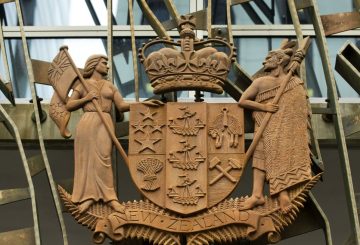Pameran Kiingi Tuheitia Portraiture Award akan berlangsung pada Mei 2023. Penyelenggara acara bertujuan untuk memperluas ruang lingkup potret Māori dan memperkuat hubungan antara Kiingitanga dan Waitangi.
Museum Te Kōngahu di Waitangi akan menjadi tuan rumah pameran, yang akan menampilkan karya-karya dari 43 finalis Kiingi Tuheitia Portraiture Award 2023. Kompetisi nasional dua tahunan ini mendorong seniman Māori yang muncul untuk membuat potret nenek moyang mereka, yang dikenal sebagai tūpuna.
Penghargaan dan pameran berfungsi sebagai platform untuk menyoroti keterampilan dan bakat seniman Māori pemula ini, yang menggunakan berbagai media artistik visual. Penghargaan Potret Kiingi Tuheitia pertama kali diluncurkan pada Agustus 2020, dengan kompetisi perdana dan upacara penghargaan berlangsung pada tahun 2021.
Chanel Clarke, kepala kuratorial dan pembelajaran di Waitangi Treaty Grounds, mengungkapkan kegembiraannya tentang menjadi tuan rumah pameran tur, terutama setelah kunjungan Raja ke Waitangi awal tahun ini.
Clarke mencatat bahwa pameran ini menampilkan beragam seni, dengan banyak seniman mendorong batas bagaimana mereka mewakili tupuna mereka. Beberapa karya bahkan menggabungkan elemen digital, termasuk karya buatan AI. Perpaduan bentuk seni tradisional dan modern ini menampilkan peluang menarik yang tersedia bagi seniman Māori saat ini.
Menurut Clarke, potret Māori dapat mengambil bentuk apa pun yang dipilih seniman Māori, tanpa terbatas pada cita-cita Eropa. Dia menekankan bahwa pilihan representasi sepenuhnya terserah para seniman. Bentuk seni tradisional Māori seperti tanah liat (uku) dan ukiran (whakairo) juga termasuk dalam pameran.
Kiingi Tuheitia Portraiture Award menargetkan seniman baru, banyak di antaranya berpartisipasi untuk kedua kalinya. Clarke menyoroti bahwa pameran ini memberikan kesempatan berharga bagi para seniman ini untuk membuat tanda mereka dan mendapatkan eksposur.
Pameran Kiingi Tuheitia Portraiture Award akan dibuka untuk umum di Lapangan Perjanjian Waitangi hingga 11 Agustus 2024.


















































-360x245.jpg)









